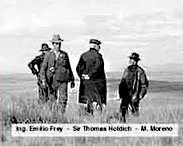1902 Referendum: historical research book See map
The book is based on researches, that for more than four years held the Direction of Culture of Trevelin with writer and journalist Gustavo De Vera, seeking to reconstruct those events and get answers to questions like "who", "when" , "where", "how" and "why" led to these events.
As part of that investigation, it have been obtained valuable documentation (largely unpublished until now), which allows the detailed reconstruction of such events and to place the Referendum on April 30 in a wider context that gives a national relevance and even binational.
Winds of War
Just to note as an example, the considerations can be seen on the pre-war status who had reached Chile and Argentina motivated by border disputes, in such an escalation that in 1902 an armed conflict was imminent. Data can be indicated as the Law Richieri, creating the Selective Service was promulgated precisely to allow a massive incorporation of men to Argentine armed forces. The purchase of warships from both countries was also another sign of growing beligeración.
The referendum
 Mr. Emilio Frey, Sir Thomas Holdich and the perito M. Moreno.
Mr. Emilio Frey, Sir Thomas Holdich and the perito M. Moreno.In this scenario, the Boundary Commission (composed of Sir Thomas Holdich, the Perito Moreno and the Chilean representative) walked the Andean Patagonian valleys observing in the place what so far the warring parties had submitted in writing to the arbitral tribunal Great Britain.
Upon arriving at the Colony October 16, they were received by a large audience at School 18. During the three days they stayed there, each and every one of the members of the Commission experienced different sensations and performed, in turn, their own observations. But the impression left in the commissioners by this household group manifesting through songs, poems and hymns and their explicit determination for Argentina's sovereignty over their lands, was without doubt contributed to the peace process wanted for both countries.
The book
The research has also allowed the reconstruction of small facts and anecdotes that help to acclimate the facts at the time and place of occurrence, and to describe actions and attitudes of the protagonists and those characters surrounding circumstances.
The book is designed as a simple understanding text, while comprehensive in its information content. With the idea average of 150 pages, the book has about 70 illustrations or photographs selected from nearly a thousand that make up the photographic archive that is built through the implementation of this project and his older brother (also running): the tell the story of the Valle 16 de Octubre.
The contents are separated into chapters where are included the most prominent elements on the events of April 30, 1902. The first chapter, perhaps the most literary of all, seeks to narrate the local events that took place between 27 April and 1 May. The cruise of Holdich, Moreno and the Chilean representative in the hours prior to arrival at the Valle 16 de Octubre, the reception that was given to them by the people, the events that led to the so-called "referendum," the reconstruction of small gestures and details that framed and somehow defined the subsequent events.
The account of these events is based on documentation and testimony gathered, whose sources are referenced in footnotes page. The remaining chapters act by breaking each of the elements involved in the events of April 30 and carry out their main features to enable a better understanding of how and why they interacted in this way in the events. The figures of Argentine and Chilean representatives who were in the Valley 16 de Octubre, have each chapter itself, as there is one dedicated to Sir Thomas Holdich.
There are inclueded a brief history of the Valley 16 de Octubre and its population, the institutional history of the School 18, since its creation in 1895 by the National Government, history of education in the Valley, as well as memory of several of its former students through oral testimonies collected for this project.
The situation of war escalation that nearly caused a war between the two countries and the Covenants of May 1902 that prevented it, are also contained in this work. A considerable space is intended for exposures of Argentina and Chile basing their claims to the border conflict, and, of course, the decision of King Edward VII as arbitrator in the dispute.
On April 30, 1902, a group of Welsh farming families, who lived in the Colony of Valley 16 de Octubre, were questioned by a Boundary Commission studying border disputes between Argentina and Chile about what they recognized sovereignty over the land they occupied. The determination of those people was in favor of Argentina.
Viajes por la Patagonia
Related Articles
© Patagonia.com.ar 2026 | Todos los derechos reservados.
